

Stargate and Ester Dean, Making Music Hits. On a mild Monday afternoon in mid-January, Ester Dean, a songwriter and vocalist, arrived at Roc the Mic Studios, on West Twenty-seventh Street in Manhattan, for the first of five days of songwriting sessions.
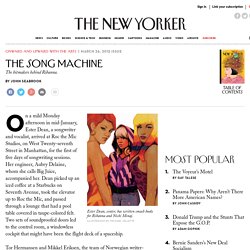
Her engineer, Aubry Delaine, whom she calls Big Juice, accompanied her. Dean picked up an iced coffee at a Starbucks on Seventh Avenue, took the elevator up to Roc the Mic, and passed through a lounge that had a pool table covered in taupe-colored felt. Two sets of soundproofed doors led to the control room, a windowless cockpit that might have been the flight deck of a spaceship. Tor Hermansen and Mikkel Eriksen, the team of Norwegian writer-producers professionally known as Stargate, were waiting there for Dean. Both are tall and skinny ectomorphs with pale shaved heads who would not look out of place in a “Matrix” movie.
Most of the songs played on Top Forty radio are collaborations between producers like Stargate and “top line” writers like Ester Dean. How did this happen? The Creative Act: Marcel Duchamp's 1957 Classic, Read by the Artist Himself. John Cleese on the 5 Factors to Make Your Life More Creative. By Maria Popova “Creativity is not a talent.

Learning on the Edge. One of the first exercises I ask the pre-service and in-service teachers in my Psychology of Learning course to do is define learning.

This is not a look-up-in-the-dictionary type of activity. They are asked to do so using their own thoughts, images, body movements, and chants/music. It is a difficult exercise. Actually, I find it quite baffling that educators don’t more often explore the question, “What is learning?” Magic Hours: Tom Bissell on the Secrets of Creators and Creation. By Maria Popova “To create anything… is to believe, if only momentarily, you are capable of magic.”
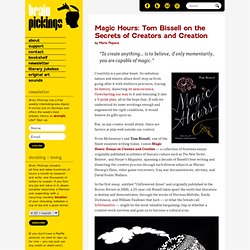
Creativity is a peculiar beast. Its nebulous nature and elusive allure don’t stop us from going after it with stubborn precision, tracing its history, dissecting its neuroscience, flowcharting our way to it and itemizing it into a 5-point plan, all in the hope that, if only we understood its inner workings enough and engineered the right conditions, it would bestow its gifts upon us. But, as any creator would attest, there are factors at play well outside our control. Take Melville’s Moby-Dick, for instance. On Scientific Taste. By Maria Popova “Our taste derives from the summation of all that we have learnt from others, experienced and thought.”

Cambridge University animal pathology professor W. I. B. Beveridge’s 1957 gem The Art of Scientific Investigation (public library; public domain) is the gift that keeps on giving. Networked Knowledge and Combinatorial Creativity. By Maria Popova Why creativity is like LEGO, or what Richard Dawkins has to do with Susan Sontag and Gandhi.
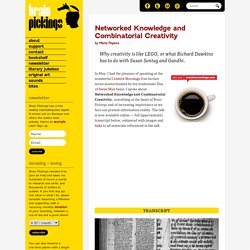
In May, I had the pleasure of speaking at the wonderful Creative Mornings free lecture series masterminded by my studiomate Tina of Swiss Miss fame. I spoke about Networked Knowledge and Combinatorial Creativity, something at the heart of Brain Pickings and of increasing importance as we face our present information reality. The talk is now available online — full (approximate) transcript below, enhanced with images and links to all materials referenced in the talk. These are pages from the most famous florilegium, completed by Thomas of Ireland in the 14th century.
In talking about these medieval manuscripts, Adam Gopnik writes in The New Yorker: Our minds were altered less by books than by index slips.” You may have heard this anecdote. Here’s the same sentiment from iconic designer Paula Scher on the creation of the famous Citi logo: Kind of LEGOs. And I like this last part. Advice on Living the Creative Life from Neil Gaiman. Remembering Ray Bradbury with 11 Timeless Quotes on Joy, Failure, Writing, Creativity, and Purpose.
By Maria Popova The literary hero in his own words.
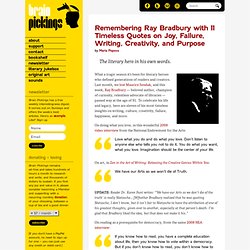
What a tragic season it’s been for literary heroes who defined generations of readers and creators. Andrew Zuckerman: Curiosity and Rigor are the Secret to Creativity. Austin Kleon on 10 Things Every Creator Should Remember But We Often Forget. By Maria Popova What T.S.
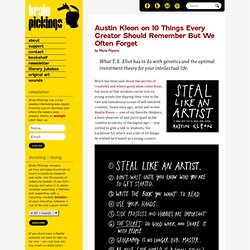
Eliot has to do with genetics and the optimal investment theory for your intellectual life. Much has been said about the secrets of creativity and where good ideas come from, but most of that wisdom can be lost on young minds just dipping their toes in the vast and tumultuous ocean of self-initiated creation. Some time ago, artist and writer Austin Kleon — one of my favorite thinkers, a keen observer of and participant in the creative economy of the digital age — was invited to give a talk to students, the backbone for which was a list of 10 things he wished he’d heard as a young creator: So widely did the talk resonate that Kleon decided to deepen and enrich its message in Steal Like an Artist — an intelligent and articulate manifesto for the era of combinatorial creativity and remix culture that’s part 344 Questions, part Everything is a Remix, part The Gift, at once borrowed and entirely original. The book opens with a timeless T.S.
Donating = Loving. Isaac Asimov on Creativity in Education & The Future of Science. Twilight Zone Creator Rod Serling on Where Good Ideas Come From.